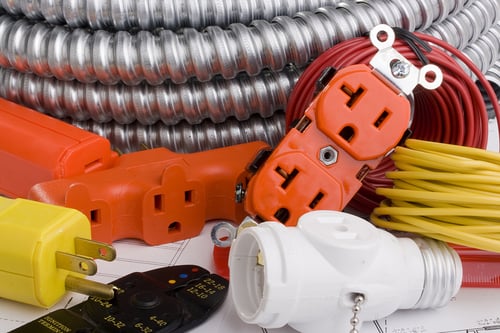Top 3 Hidden Electrical Issues That May Affect Your Building

The general public is aware that circuit breakers trip when there are electrical faults, preventing equipment damage and fires. However, there are electrical issues that don’t produce high-magnitude current or immediate damage, and they tend to stay undetected for long periods. These less-severe electrical problems are not easily noticed, but they shorten the service life of equipment while reducing performance.
Get a code-compliant electrical design for your construction project.
Voltage Drop
When electricity moves through a material there is always a voltage drop, which is determined by the current (amperes) and resistance (ohms). Although wiring has a low resistance, there is still a voltage drop involved. Therefore, the voltage supplied to a circuit is higher than the voltage received by loads connected to the circuit.
Electrical devices can normally operate within a voltage range, and as a result they tolerate a small voltage drop. However, excessive voltage drop is detrimental for the performance of many devices, and it can even cause damage. Severe voltage drop has many possible causes:
-
Inadequate wiring: Wiring is normally selected based on the load current, but long circuits may need a higher capacity to reduce resistance and voltage drop.
-
Low supply voltage: External issues can affect voltage at the source, lowering the supply voltage for electrical devices even if the wiring is adequate.
Keep in mind that wiring of a higher ampacity is also more expensive, and electrical engineers do not recommend oversizing for this reason. You should use a wire size that carries the load current safely while minimizing voltage drop. The National Electrical Code (NEC) recommends a voltage drop under 3% for branch circuits, and under 5% for feeder circuits.

Voltage drop can be controlled with a professional design from qualified electrical engineers. Based on the loads connected to each circuit, they can specify a wire size that keeps voltage drop within the range recommended in the NEC.
Overvoltage is the opposite phenomenon, but it is much less frequent. Since wiring always causes a voltage drop, overvoltage is normally a power supply issue, or it may be caused momentarily by some devices. The main consequences of overvoltage are additional energy consumption and potential damage to equipment.
Voltage Imbalance
Three-phase power is commonly used in large commercial and industrial settings. Ideally, electrical loads should be evenly balanced, but in practice a perfect balance is not possible. As a result, there will be variation of voltage and current between conductors in a three-phase system.
While a low-magnitude imbalance is tolerated, some types of equipment are affected when voltage imbalance grows. Three-phase motors are affected the most, suffering the following consequences:
-
Overheating: While a 2% imbalance causes 8% temperature rise, a 5% imbalance leads to 50% temperature rise.
-
Poor mechanical performance: A motor with unbalanced voltage cannot deliver a steady torque at the shaft, and it also suffers from increased vibration and noise.
-
Shorter service life: This can be expected when a motor is subject to overheating and vibration. Bearings and winding insulation are typically the first components damaged.
Voltage imbalance is impossible to eliminate completely, but it can me mitigated with evenly distributed loads. In cases where the loads cannot be balanced effectively, power electronics can be deployed to achieve a balanced voltage.
Harmonics
Harmonics are a complex electrical phenomenon - their description is very technical and their mathematical model is equally complex.
-
When electrical loads have a linear relationship between voltage and current, their currents cancel out when they meet in the neutral conductor. When only linear loads are present, any current in the neutral conductor is due to phase imbalance only.
-
On the other hand, non-linear loads have more complex current signals, which add up instead of cancelling when they meet at the neutral conductor. These are called harmonic currents.
The main consequence of harmonics is overheating, which can be detrimental for both wiring and equipment. Harmonics can also interfere with the performance of many types of equipment, causing more frequent breakdowns and reducing service life.
Since non-linear loads are required for many applications, harmonics require specially-designed filtering devices. These filters contain harmonics at the source, preventing their propagation to other loads and circuits.
Conclusion
The electrical conditions described in this article are characterized by being able to stay undetected for long periods, without causing sudden faults but gradually damaging installations and equipment.
By working with qualified electrical engineers during the design stage, you can ensure your installation achieves optimal performance. On the other hand, if you manage an existing building that has experienced an increased number of electrical issues, you can get a professional assessment to determine their causes.

Michael Tobias
Michael Tobias, the Founding Principal of NY Engineers, currently leads a team of 150+ MEP/FP engineers and has led over 4,000 projects in the US
Join 15,000+ Fellow Architects and Contractors
Get expert engineering tips straight to your inbox. Subscribe to the NY Engineers Blog below.

